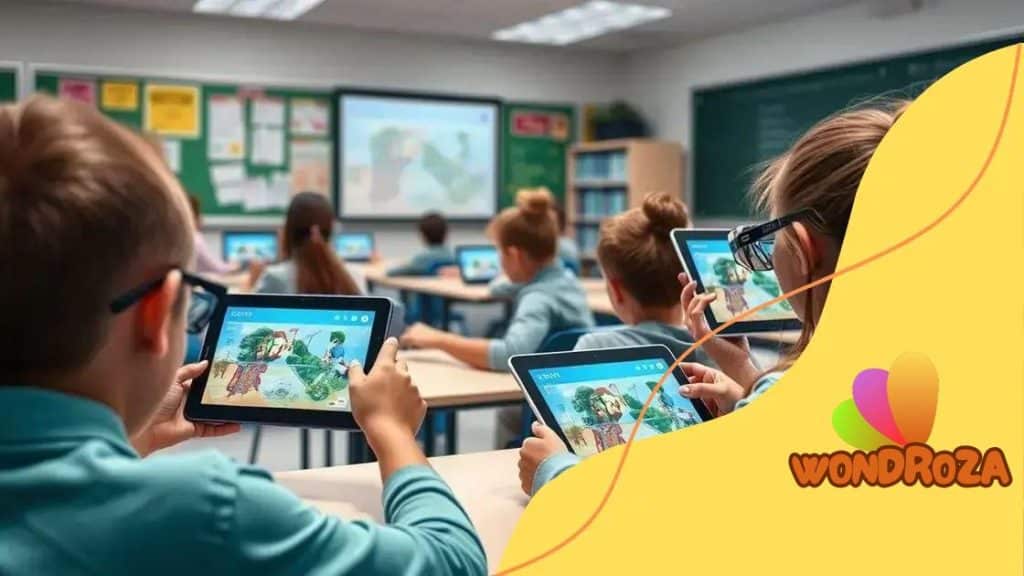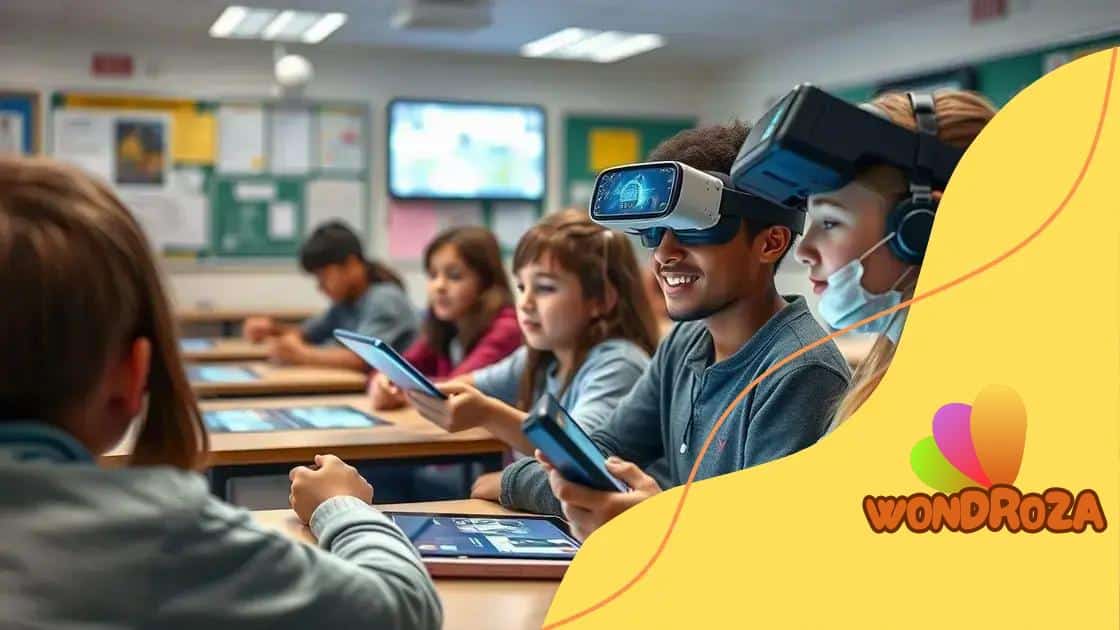How AR is being used for hands-on learning experiences

Augmented reality (AR) enhances hands-on learning experiences by making lessons interactive, engaging students in visualizing complex concepts and fostering collaboration, thus improving understanding and retention in various subjects.
How AR is being used for hands-on learning experiences opens up exciting possibilities for students and educators alike. Imagine exploring complex subjects through immersive technology that brings learning to life. Let’s dive into how augmented reality is making this happen.
Understanding augmented reality in education
Understanding augmented reality in education is essential for grasping how technology can enhance learning experiences. By merging digital content with the physical world, AR transforms traditional teaching methods into interactive and engaging lessons.
What is Augmented Reality?
Augmented reality is the overlay of digital information, such as images or sounds, on the real world. This technology allows students to see and interact with content in informative and memorable ways.
How AR is Used in Classrooms
In the classroom, AR can change how students learn about various subjects. Here are a few creative applications:
- Visualizing historical events through 3D models
- Exploring scientific concepts with interactive diagrams
- Simulating real-world scenarios for practical experience
Teachers can integrate AR into their lessons to promote active participation. By fostering a more engaging learning environment, students may connect better with the material.
Moreover, AR can cater to different learning styles. Visual learners can benefit greatly from graphics, while kinesthetic learners engage through hands-on interactions. This versatility is crucial for today’s diverse classrooms.
Benefits of Using AR in Education
The benefits of using AR in education are vast. Not only does it hold students’ attention, but it also enhances comprehension. Research indicates that students retain information better when they can visualize and interact with it. This can lead to improved outcomes across various subjects.
Additionally, AR promotes collaboration among students. By working together on AR projects, pupils develop teamwork skills and learn from each other. This communal approach enriches the learning experience, making it more robust.
Ultimately, understanding augmented reality in education opens doors to innovative teaching strategies. As technology evolves, so does the potential for enhancing educational methods. Educators who embrace AR can lead their students to success in an ever-changing world.
Benefits of AR for practical learning
The benefits of AR for practical learning are numerous and impactful. With augmented reality, students experience a new level of engagement that traditional methods often lack. This interactive approach not only captivates their attention but also deepens understanding.
Enhancing Engagement
One of the primary advantages of AR is its ability to enhance student engagement. By integrating digital elements into real-world environments, students can see the relevance of what they are learning. This connection makes learning more exciting and memorable.
Additionally, AR provides opportunities for hands-on learning, which is crucial for grasping complex concepts. Students can manipulate virtual objects, conduct experiments, and visualize data—all while staying in their physical classrooms. This active participation fosters better retention of information.
Improving Knowledge Retention
When students engage with augmented reality, they not only learn but also retain knowledge more effectively. Studies show that the combination of sensory stimuli enhances memory recall. By visualizing concepts through AR, students can remember information longer.
- Interactivity: Students interact with the material, making learning dynamic.
- Visualization: Abstract concepts become tangible, simplifying complex ideas.
- Motivation: The novelty of AR encourages students to participate and explore.
This focus on practical experience is especially beneficial in subjects like science and mathematics, where understanding principles is critical. For example, virtual labs allow students to conduct experiments safely and repeatedly without the usual constraints of time and resources.
Fostering Collaboration
AR also encourages collaboration among students. When working on AR projects, they can share their learning experiences and discoveries, enhancing social skills. Collaborating through technology promotes teamwork and communication, essential skills for the future.
In essence, the benefits of AR for practical learning extend beyond the classroom. As students engage with new technologies, they prepare for a world that increasingly relies on digital solutions. By incorporating augmented reality into education, teachers equip students with the skills they need to thrive.
Case studies: AR in classrooms

Case studies of AR in classrooms provide real-world examples of how this technology is reshaping education. Schools across the globe are using augmented reality to boost engagement and improve learning outcomes.
Successful implementations
One notable example is a high school in California that integrated AR into its biology curriculum. Students used AR applications to explore 3D models of the human body. By viewing organs in detail, they gained a deeper understanding of anatomy.
Another case study comes from a middle school in New York, where AR is used in history lessons. Students can interact with historical artifacts as if they were actually in a museum. This immersive experience makes learning about history more tangible and fascinating.
Key findings
Research shows that students in AR-enhanced classes often score higher on assessments than those in traditional settings. Here are some key findings from various studies:
- Increased engagement: Students are more involved in lessons when using AR.
- Improved retention: Learners remember information better when they can visualize it.
- Enhanced collaboration: Group projects with AR foster teamwork and communication skills.
Moreover, educators report higher satisfaction levels among students who participate in AR-based learning. For instance, one teacher noted that his students were more motivated to complete assignments when using AR tools.
These case studies highlight the versatility of augmented reality in various subjects. From science to history, AR helps to create engaging, hands-on learning environments. As more schools adopt this technology, the potential for impactful learning continues to grow.
Tools and apps for AR learning experiences
When it comes to AR learning experiences, using the right tools and apps can make all the difference. These technologies help bring lessons to life and make learning more engaging for students. With a variety of options available, educators have access to powerful resources to enhance their teaching.
Popular AR Applications
There are several applications that have gained popularity in classrooms.
- Merge Cube: This interactive tool allows students to explore subjects like anatomy and space by holding a physical cube that displays mixed reality content.
- zSpace: zSpace provides immersive experiences that blend AR and VR, making science and math concepts accessible and understandable.
- Aurasma: Now known as HP Reveal, this app lets users create their own AR experiences by overlaying digital content on real-world images.
Using these tools, educators can engage students in ways that traditional methods cannot. For instance, with Merge Cube, students can observe a 3D model of the solar system and interact with it using their tablets, enhancing their understanding of space concepts.
Benefits of Using AR Tools
Incorporating AR tools into lessons provides numerous benefits. Firstly, it enhances engagement, turning passive learners into active participants. Secondly, these tools often promote critical thinking as students analyze and manipulate digital content. Additionally, AR applications cater to diverse learning styles, making lessons accessible for everyone.
Moreover, teachers can personalize learning through AR. For instance, educators can create custom AR experiences that align with their curriculum and specific lesson goals. This flexibility allows for tailored instruction that meets varied student needs.
Implementation in Classrooms
Implementing AR in classrooms can be simple and effective. Teachers can start with small projects, gradually expanding the use of AR tools as they become more familiar with the technology. Professional development sessions can also support teachers in integrating these tools into their teaching methods, ensuring they feel confident while using them.
Overall, the availability of various AR tools and apps significantly enhances learning experiences, making them more interactive and engaging for students. As technology continues to evolve, these resources will become even more refined, providing endless possibilities for education.
Future trends in hands-on learning with AR
Future trends in hands-on learning with AR are shaping the way education evolves. As technology continues to advance, the potential for augmented reality in classrooms becomes even more exciting. Educators are starting to envision a future where learning is not only interactive but also deeply immersive.
Emerging Technologies
New developments in AR technology are paving the way for more engaging learning experiences. For instance, improvements in mobile devices and AR glasses will make accessing augmented content easier for students. As these tools become more accessible, we can expect to see broader adoption in classrooms.
Additionally, the integration of artificial intelligence into AR systems may personalize learning experiences. AI can adapt content to each student’s learning pace, offering tailored activities that enhance understanding and retention.
Collaborative Learning Environments
Future applications of AR will emphasize collaboration among students. Virtual classrooms may allow learners from different locations to interact with each other in real-time while exploring shared AR environments. This ability to work together in an immersive space could foster critical teamwork and communication skills.
- Remote learning capabilities: Students can connect with peers globally to solve problems using AR.
- Group projects: Teams can collaborate on projects by manipulating shared virtual objects.
- Peer-to-peer learning: More knowledgeable students can assist their classmates in exploring AR content.
Such collaborative features would make educational experiences richer and more socially engaging. As we look ahead, hands-on learning will likely involve not just single students but entire classrooms working together in dynamic ways.
Real-World Applications
In the near future, we may see more real-world applications of AR in various fields. For example, vocational training can benefit greatly by simulating real-life scenarios that students will face in their careers. Medical students could practice surgical techniques using AR simulations, while engineering students might design and test prototypes in virtual environments.
As AR becomes integrated into curricula across diverse subjects, it will help bridge the gap between theoretical knowledge and practical skills. This could lead to a generation of students who are better prepared for their future careers.
Ultimately, these future trends in hands-on learning with AR promise to transform education, making it more engaging, collaborative, and relevant to the needs of students. As schools adapt to these innovations, the learning landscape will shift dramatically, creating exciting opportunities for students everywhere.
FAQ – Frequently Asked Questions about AR in Education
How does augmented reality enhance learning experiences?
Augmented reality engages students with interactive content, making lessons more enjoyable and memorable. It helps students visualize complex concepts in a tangible way.
What are some popular AR tools for classrooms?
Some popular AR tools include Merge Cube, zSpace, and Aurasma. These applications allow students to explore subjects through immersive digital content.
Can AR be used for remote learning?
Yes, AR can facilitate remote learning by enabling students to interact with virtual environments and collaborate with peers regardless of their physical location.
What are the future trends for AR in education?
Future trends include more personalized learning experiences with AI integration, enhanced collaborative environments, and increased use of AR in vocational training and real-world applications.





